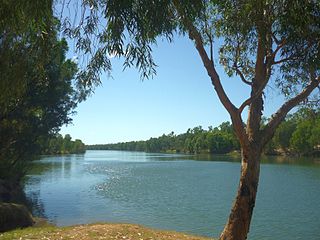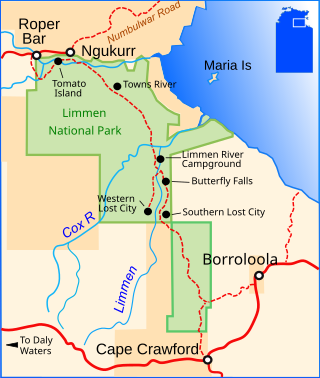
Mount Isa is a city in the Gulf Country region of Queensland, Australia. It came into existence because of the vast mineral deposits found in the area. Mount Isa Mines (MIM) is one of the most productive single mines in world history, based on combined production of lead, silver, copper and zinc.
Falconbridge Limited was a Toronto, Ontario-based natural resources company with operations in 18 countries, involved in the exploration, mining, processing, and marketing of metal and mineral products, including nickel, copper, cobalt, and platinum. It was listed on the TSX and NYSE (FAL), and had revenue of US$6.9 billion in 2005. In August 2006, it was absorbed by Swiss-based mining company Xstrata, which had formerly been a major shareholder.

The Ranger Uranium Mine was a uranium mine in the Northern Territory of Australia. The site is surrounded by, but separate from Kakadu National Park, 230 km east of Darwin. The orebody was discovered in late 1969, and the mine commenced operation in 1980, reaching full production of uranium oxide in 1981 and ceased stockpile processing on 8 January 2021. Mining activities had ceased in 2012. It is owned and operated by Energy Resources of Australia (ERA), a public company 86.33% owned by Rio Tinto Group, the remainder held by the public. Uranium mined at Ranger was sold for use in nuclear power stations in Japan, South Korea, China, UK, France, Germany, Spain, Sweden and the United States.

Rum Jungle is a locality in the Northern Territory of Australia located about 105 kilometres south of Darwin on the East Branch of the Finniss River. It is the site of a uranium deposit, found in 1949, which has been mined.

Xstrata plc was an Anglo-Swiss multinational mining company headquartered in Zug, Switzerland and with its registered office in London, United Kingdom. It was a major producer of coal, copper, nickel, primary vanadium and zinc and the world's largest producer of ferrochrome. It had operations in 19 countries across Africa, Asia, Australasia, Europe, North America and South America.

Kidd Mine or Kidd Creek Mine is an underground base metal (copper-zinc-silver) mine 24 km (15 mi) north of Timmins, Ontario, Canada. It is owned and operated by Swiss multinational Glencore Inc. The mine was discovered in 1963 by Texas Gulf Sulfur Company. In 1981, it was sold to Canada Development Corporation, then sold in 1986 to Falconbridge Ltd., which in 2006 was acquired by Xstrata, which in turn merged with Glencore in 2013. Ore from the Kidd Mine is processed into concentrate at the Kidd Metallurgical Site, located 27 km (17 mi) southeast of the mine, which until 2010 also smelted the ore and refined the metal produced. Following the closure of the majority of the Met Site, concentrate is now shipped to Quebec for processing. Kidd Mine is the world's deepest copper-zinc mine.
Glencore plc is a Swiss multinational commodity trading and mining company with headquarters in Baar, Switzerland. Glencore's oil and gas head office is in London and its registered office is in Saint Helier, Jersey. The current company was created through a merger of Glencore with Xstrata on 2 May 2013. As of 2015, it ranked tenth in the Fortune Global 500 list of the world's largest companies. In the 2020 Forbes Global 2000, Glencore International was ranked as the 484th-largest public company in the world. As of July 2022, it is the world's largest commodity trader. In 2023, the company was ranked 59th in the Forbes Global 2000.
The McArthur Basin is a large intracratonic sedimentary basin in northern Australia, with an exposed area of about 180,000 km2. Most of it lies within the northeastern Northern Territory, but extends over the border into the state of Queensland. The basin contains thick marine and non-marine sedimentary rocks which were deposited from the late Paleoproterozoic to the early Mesoproterozoic. The basin also contains some volcanic rocks and related intrusive igneous rocks. The McArthur Basin hosts the world-class McArthur River mine (HYC) zinc-lead-silver deposit and several smaller mineral and diamond deposits.
Mount Isa Mines Limited ("MIM") operates the Mount Isa copper, lead, zinc and silver mines near Mount Isa, Queensland, Australia as part of the Glencore group of companies. For a brief period in 1980, MIM was Australia's largest company. It has pioneered several significant mining industry innovations, including the Isa Process copper refining technology, the Isasmelt smelting technology, and the IsaMill fine grinding technology, and it also commercialized the Jameson Cell column flotation technology.

The McArthur River is a river in the Northern Territory of Australia which flows into the Gulf of Carpentaria at Port McArthur, opposite the Sir Edward Pellew Group of Islands. The river was named by Ludwig Leichhardt while he explored the area in 1845. He named the River after James MacArthur and the MacArthur family of Camden, who were enthusiastic supporters of his expedition. The McArthur River has significance for the local Aboriginal communities, who use it for fishing and other traditional activities.
Sphinx Resources Ltd. is a Canadian company focused on exploration of precious and base metals within mining rights in Quebec. It is listed on the TSX Venture Exchange. The company was formerly named Donner Metals Ltd., headquarters are in Vancouver, and active in other provinces, but changed names in 2014 and moved its headquarters to Montreal, Quebec. As Donner, its principal project was a 35-65 joint venture with Glencore Xstrata in Matagami, Quebec.
The IsaMill is an energy-efficient mineral industry grinding mill that was jointly developed in the 1990s by Mount Isa Mines Limited and Netzsch Feinmahltechnik ("Netzsch"), a German manufacturer of bead mills. The IsaMill is primarily known for its ultrafine grinding applications in the mining industry, but is also being used as a more efficient means of coarse grinding. By the end of 2008, over 70% of the IsaMill’s installed capacity was for conventional regrinding or mainstream grinding applications, with target product sizes ranging from 25 to 60 µm.
The Frieda River Project is a large open cast mine and associated infrastructure in the Sandaun and East Sepik Provinces of Papua New Guinea. The mine is located along a tributary of the Sepik River. The deposit is a large copper-gold porphyry deposit. The project includes a hydroelectric scheme to provide electricity. and service by the Frieda River Airport. In 2010, the mine had estimated reserves of 14.3 million oz of gold.

Limmen National Park, announced in 2012, is the third largest national park in the Northern Territory, after Judbarra / Gregory National Park, with an area of approximately 9,369 square kilometres (3,617 sq mi). Located about 600 km south-east of Darwin on the Gulf of Carpentaria, the park incorporates wetlands, sandstone structures and numerous rivers, including the Limmen Bight River from which the park takes its name.

Zinc mining is the process by which mineral forms of the metal zinc are extracted from the earth through mining. A zinc mine is a mine that produces zinc minerals in ore as its primary product. Common co-products in zinc ores include minerals of lead and silver. Other mines may produce zinc minerals as a by-product of the production of ores containing more valuable minerals or metals, such as gold, silver or copper. Mined ore is processed, usually on site, to produce one or more metal-rich concentrates, then transported to a zinc smelter for production of zinc metal.
The George Fisher Mine is a mine located near Mount Isa in Queensland, Australia. It is one of the largest zinc, lead and silver mines in the world. The mine is located 20 kilometres (12 mi) north of Mount Isa in North West Queensland. It mine has estimated reserves of 150.4 million ounces of silver. It was named after George Fisher, the former chairman of Mount Misa Mines.
Las Bambas copper mine is an open-pit copper mine in the Cotabambas province of Peru. With over a billion tons of copper ore, the deposit is one of the largest in the world and produces 2% of global copper. Las Bambas also produces molybdenum concentrates. Development began on the mine in August 2015 and production began in early 2016.
Chanston James "Chansey" Paech is an Australian politician. He is a Labor Party member of the Northern Territory Legislative Assembly since 2016, representing the electorate of Namatjira until 2020 and Gwoja thereafter. He is of Arrente, Arabana and Gurindji descent.
Jack Green is an Garrwa artist and environment activist from the Northern Territory of Australia. He uses his art to campaign for land rights and the protection of his traditional Country and region, particularly against the adverse impacts of mining.









